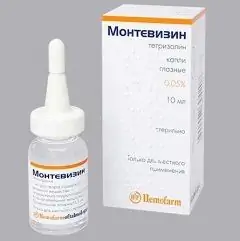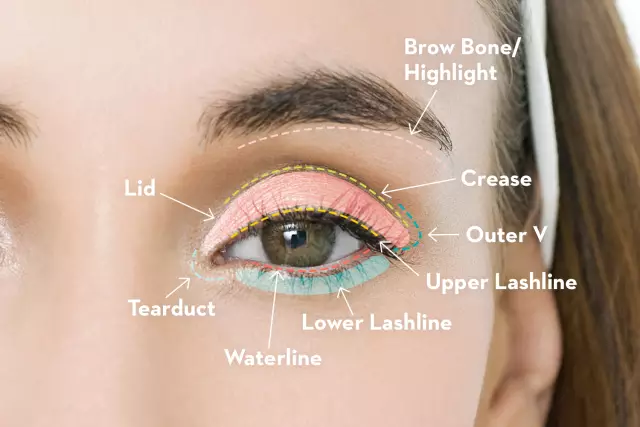- Author Rachel Wainwright [email protected].
- Public 2023-12-15 07:39.
- Last modified 2025-11-02 20:14.
Montevizin
Montevizin: instructions for use and reviews
- 1. Release form and composition
- 2. Pharmacological properties
- 3. Indications for use
- 4. Contraindications
- 5. Method of application and dosage
- 6. Side effects
- 7. Overdose
- 8. Special instructions
- 9. Application during pregnancy and lactation
- 10. Use in childhood
- 11. Drug interactions
- 12. Analogs
- 13. Terms and conditions of storage
- 14. Terms of dispensing from pharmacies
- 15. Reviews
- 16. Price in pharmacies
Latin name: Montevizin
ATX code: S01GA02
Active ingredient: tetrizoline (tetryzoline)
Manufacturer: Hemomont (Montenegro)
Description and photo update: 2018-21-11
Prices in pharmacies: from 157 rubles.
Buy

Montevizin is a local drug with a vasoconstrictor effect used in ophthalmology.
Release form and composition
Dosage form of release - eye drops: transparent, colorless (in a cardboard box 1 bottle of 10 ml).
Composition of 1 ml drops:
- active substance: tetrizoline hydrochloride - 0.5 mg;
- auxiliary components: benzalkonium chloride - 0.1 mg; sodium tetraborate decahydrate - 0.57 mg; sodium chloride - 1.8 mg; disodium edetate dihydrate - 1 mg; boric acid - 12 mg; water for injection - up to 1 ml.
Pharmacological properties
Pharmacodynamics
Montevizin belongs to alpha-adrenergic agonists. It is intended for topical use in ophthalmology. It has a decongestant and vasoconstrictor effect.
The development of the vasoconstrictor effect without secondary reactive hyperemia is observed after several minutes and lasts for 4-8 hours.
Pharmacokinetics
When applied topically, tetrizoline hydrochloride has a low systemic absorption.
Indications for use
- edema of the conjunctiva, irritation of the conjunctiva, secondary hyperemia in allergic eye diseases;
- edema / hyperemia of the conjunctiva associated with various nonspecific causes (condition after tonometry, reading, cigarette smoke, dust, swimming, smog, driving).
Contraindications
Absolute:
- glaucoma;
- endothelial-epithelial corneal dystrophy;
- age up to 6 years;
- pregnancy and the period of breastfeeding;
- individual intolerance to the components of the drug.
Relative (Montevizin is prescribed under medical supervision):
- arterial hypertension;
- aneurysm;
- arrhythmia;
- pheochromocytoma;
- thyrotoxicosis;
- severe organic diseases of the heart and blood vessels, including ischemic heart disease;
- diabetes;
- combination therapy with monoamine oxidase inhibitors and other drugs that increase blood pressure.
Instructions for use of Montevizin: method and dosage
Montevizin should be instilled into the conjunctival sac of both eyes 2 to 3 times a day, 1-2 drops.
If there is no improvement within 48 hours, a doctor should be consulted before further therapy.
Side effects
- systemic reactions (the development of disorders is possible with the use of high doses): insomnia, headache, hyperglycemia, allergic reactions, cardiac dysfunction, drowsiness, nausea, tremor, weakness, dizziness, palpitations, tachycardia, increased blood pressure;
- local reactions: burning sensation in the eye, mydriasis, reactive hyperemia, lacrimation, increased intraocular pressure.
Overdose
The main symptoms are: arrhythmias, mydriasis, fever, cyanosis, convulsions, increased blood pressure, pulmonary edema, cardiac arrest, dyspnea. With excessive total absorption of imidazole derivatives, depression of the central nervous system may develop, accompanied by collapse, hypothermia, drowsiness, apnea, bradycardia and coma. The highest likelihood of overdose symptoms associated with the absorption of Montevizin in young children, especially in the case of ingestion of drops.
The antidote is unknown. For therapy, gastric lavage, activated carbon, oxygen inhalation, drugs with antipyretic and antiepileptic effects are prescribed. In order to lower blood pressure, slow intravenous administration of 5 mg of phentolamine (in saline) or its ingestion at a dose of 100 mg is indicated.
special instructions
Long-term treatment and overdose, especially in children, should be avoided.
Before instilling Montevizin, contact lenses must be removed, they can be installed after about 15 minutes. Given the likelihood of impairing the transparency of soft contact lenses, it is recommended to avoid direct contact with eye drops.
Seeing a doctor is required in cases of the development of the following disorders: intense pain in the eyes, headache, loss of vision, the sudden appearance of floating spots before the eyes, redness of the eyes, double vision, pain when exposed to light.
Influence on the ability to drive vehicles and complex mechanisms
Due to the likelihood of visual impairment, patients should refrain from driving vehicles during the period of using Montevizin eye drops.
Application during pregnancy and lactation
According to the instructions, Montevizin is contraindicated during pregnancy / lactation.
Pediatric use
Eye drops Montevizin are contraindicated in patients under 6 years of age.
Drug interactions
Possible interactions:
- inhalation anesthetics (cyclopropane, halothane and other halogenated anesthetics): the likelihood of ventricular fibrillation increases;
- monoamine oxidase inhibitors, maprotiline, tricyclic antidepressants: the likelihood of a hypertensive crisis increases.
Analogs
Analogues of Montevizin are: Octilia, VisOptics, Vizin Classic.
Terms and conditions of storage
Store at 15-25 ° C. Keep out of the reach of children.
Shelf life - 3 years, after the first opening of the bottle - 30 days.
Terms of dispensing from pharmacies
Available without a prescription.
Reviews about Montevizin
According to reviews, Montevizin has an acceptable cost and is effective for redness and eye irritation. It is noted that the drops do not burn the eyes when instilled. Some patients indicate the development of side effects and the lack of a therapeutic effect.
Price for Montevizin in pharmacies
The approximate price for Montevizin (1 bottle of 10 ml) is 130-146 rubles.
Montevizin: prices in online pharmacies
|
Drug name Price Pharmacy |
|
Montevizin 0.05% eye drops 10 ml 1 pc. 157 r Buy |
|
Montevizin eye drops 0.05% 10ml 174 r Buy |

Maria Kulkes Medical journalist About the author
Education: First Moscow State Medical University named after I. M. Sechenov, specialty "General Medicine".
Information about the drug is generalized, provided for informational purposes only and does not replace the official instructions. Self-medication is hazardous to health!






